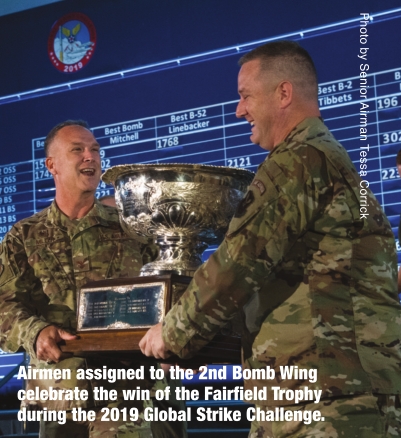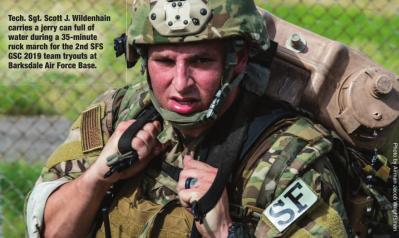Barksdale Wins Again

The 2nd Bomb Wing at BAFB scores Fairfield Trophy for best bomb wing
The 2nd Bomb Wing at Barksdale Air Force Base retained the Fairfield Trophy for best bomb wing at the recent Global Strike Challenge competition. But more than that, the Air Force got a firsthand look at Global Strike Command in action.
Global Strike Challenge is a biannual competition among the divisions of Global Strike Command designed to boost camaraderie within the command, which includes bombers, intercontinental ballistic missiles, helicopter operations and maintenance, and security forces. Participants in the 2019 Global Strike Challenge included AFGSC’s nine wings, plus units from Air Combat Command, Air Force Reserve Command and the Air National Guard.
 This year’s Global Strike Challenge was built upon AFGSC Commander Gen. Tim Ray’s “fight the base” initiative to reinvigorate and revise wing exercise programs to strengthen preparedness for potential attacks and threats.
This year’s Global Strike Challenge was built upon AFGSC Commander Gen. Tim Ray’s “fight the base” initiative to reinvigorate and revise wing exercise programs to strengthen preparedness for potential attacks and threats.
“I’m honored and humbled by the competition,” Ray said. “Our active duty, guard and reserves from all over the United States demonstrated what it means to be a striker during this grueling competition.”
Ray said the Global Strike Challenge has evolved through the years. Previous events have included a symposium where the leadership of GSC joined with defense industry leaders and the community for a professional discussion. This year’s event focused more on the challenges for the airmen and innovation. After each challenge, the leadership held a debriefing with the competitors to discuss what worked well and what could be improved. It’s that spirit of innovation, Ray said, that ultimately improves the airmen, their bases and the communities that surround them, including Shreveport and Bossier City.
“We’re spending a lot of time formalizing our effort to drive innovation,” Ray said. “We enjoy really good resources, but when you think about what we need to be incredibly capable for the future, there’s a layer of innovation that goes on top that really makes us much more competitive. So you’ll see us do more of the innovation, and part of that will bring in local entities from outside. As we start this innovation effort, this is about having a conversation with local businesses, local academic institutions, local sports teams, the medical community, to really begin to start connecting the community and the base in a more appropriate way for going forward. That’s the seed corn for this longer conversation we’re having with each of the civic leaders. Every single base has capabilities that can help.”
The competitions within Global Strike Challenge test each operation under GSC’s umbrella. The competitions date back to the days of Strategic Air Command in the 1950s and ’60s. Ray said Global Strike Challenge showcases the command’s values: Individual responsibility for mission success, critical self-assessment of our performance, uncompromising adherence to all directives, superior technical and weapons systems expertise, persistent innovation at all levels, pride in our nuclear heritage and mission, respect for the worth and dignity of every airman, and safety in all things large and small.
“The nuclear mission is the foundation of our country’s defense and the cornerstone of the security structure of the free world,” Ray said. “This competition demonstrated how our airmen are dedicated to developing and providing a safe, secure and credible force, ready to strike anywhere in the world at any time to support the President of the United States and our nation and our allies. I could not be more proud of our airmen right now.”
For Ray, Global Strike Challenge goes deeper than his current leaderships role within GSC. It’s something personal that dates back to 2009, when Strategic Air Command was rebuilt as Global Strike Command.
“I had the pleasure of being the director of operations at the onset,” he said. “One of my primary jobs was to start this competition again, so this is pretty special to me to come back and see that we’re doing it.”
Ray, a former B-52 pilot, said he remains proud of the airplane and its role. He said the B-52 fleet will be getting new engines that will make the long-range bombers more efficient and reliable, increasing their range by a minimum of 20 percent. The improvements will keep the B-52 flying into 2050, he said.
“The
B-52 is an iconic warplane,” Ray said. “It’s a statement by America
that we really care about what’s going on. By using the B-52, we’re
sending a very strong signal. I’ve flown the B-52 for years. I’ve taken
it into combat, and it’s just been an amazing machine that brought me
home every time. When they built this airplane, they gave it some really
good bones. They just overbuilt this thing back in the day, and thank
goodness they did. It’s got some good, good bones. If I compared life
remaining in the B-2 and the B-1 and the B-52 as a sign of youth, the
B-52 is the youngest plane we have. It’s such a rock-solid built
airplane.”
Those airmen assigned to the B-52 fleet who participated in Global Strike Challenge share Ray’s admiration for the airplane, and they take pride in its performance.
“Every time we have a mission, there’s no better feeling in the world than knowing, ‘Hey, I put that aircraft in the air,” said Staff Sgt. Kevin Gantt of the 2nd Aircraft Maintenance Squadron, 2nd Bomb Wing at Barksdale. “Those pilots are safe, and I know that they’re going to come back.”
Lt. Col. Chris Evans, 5th Operations Support Squadron, 5th Bomb Wing at Minot Air Force Base, said Global Strike Challenge was not only a strong internal competition within the command, but a strong show of force to the rest of the world.
“(The B-52) is the pride of the bomber force,” Evans said. “One of the things we practice in this competition is we don’t use (GPS). We go drop our weapons and show how accurate we can be even without it. It’s a really big, important part of the demonstration of how good we are, not just to ourselves, but anybody else who is watching.”
Ray said the competitive nature of Global Strike Challenge tests each airman in the competition and galvanizes each unit and the command at large. And while the competitors pay attention to the scores, they are not the be-all, end-all of the competition.
“When you talk about a competition like this, anybody in this business will tell you it’s not the competition or the test. It’s the preparation for the competition and the test that makes you better,” Ray said. “You just reveal that at the competition. I can say that about these teams out here that work very hard as teams to get better, and the scenarios we gave them are more realistic than we’ve done in the past. We want to not just make it a competition but we want to make it a learning environment where we really press ourselves into the more challenging scenarios.”
